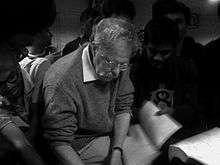David J. Griffiths
David Jeffrey Griffiths (born December 5, 1942) is an American physicist and educator. He worked at Reed College from 1978 through 2009, becoming the Howard Vollum Professor of Science before his retirement. He is not to be confused with the late physicist David J. Griffiths (David John Griffiths) of Oregon State University.[1]
David J. Griffiths | |
|---|---|
 Griffiths signing autographs for students at IIT Kanpur | |
| Born | December 5, 1942 |
| Nationality | American |
| Alma mater | Harvard University |
| Known for | Undergraduate textbooks |
| Scientific career | |
| Fields | Particle physics Electromagnetism |
| Institutions | Reed College |
| Thesis | Covariant Approach to Massless Field Theory in the Radiation Gauge (1970) |
| Doctoral advisor | Sidney Coleman |
| Signature | |
 | |
Biography
Griffiths is a graduate of The Putney School and was trained at Harvard University (B.A., 1964; M.A., 1966; Ph.D., 1970). His doctoral work ("Covariant Approach to Massless Field Theory in the Radiation Gauge") on theoretical particle physics was supervised by Sidney Coleman. He is principally known as the author of three highly regarded textbooks for undergraduate physics students: Introduction to Elementary Particles (published in 1987, second edition published 2008), Introduction to Quantum Mechanics (published in 1995, third edition published 2018), and Introduction to Electrodynamics (published in 1981, fourth edition published in 2012). He was also the recipient of the 1997 Robert A. Millikan award reserved for "those who have made outstanding scholarly contributions to physics education".[2][3] In 2009 he was named a Fellow of the American Physical Society.[4]
Books
- Griffiths, David (2008). Introduction to Elementary Particles (2nd ed.). Wiley-VCH. ISBN 978-3-527-40601-2.
- Griffiths, David (2012). Introduction to Electrodynamics (4th ed.). Addison-Wesley. ISBN 978-0-321-85656-2.
- Griffiths, David (2004). Introduction to Quantum Mechanics (2nd ed.). Prentice Hall. ISBN 0-13-111892-7.
- Griffiths, David (2012). Revolutions in Twentieth-Century Physics. Cambridge University Press. ISBN 978-1-107-60217-5.[5]
The most recent edition of each book is generally regarded as a standard undergraduate text.[6]
See also
References
- Landau, Rubin H. (Jan 2007). "In Memoriam: David John Griffiths" (PDF). Oregon State U. Physics Newsletter. 1 (1). p. 2.
- Griffiths, David (December 1997). "Millikan Lecture 1997: Is there a text in this class?". American Journal of Physics. 65 (12): 1141–1143. Bibcode:1997AmJPh..65.1141G. doi:10.1119/1.18777. Retrieved 2007-05-22.
- List of Robert A. Millikan Award Winners at the American Association of Physics Teachers website
- "New APS Fellows Nominated from the Forum of Education". APS Physics, Forum on Education. Spring 2010.
- Abernathy, William (Sep 2013). "Review of Revolutions in Twentieth-Century Physics by David Griffiths". Reed Magazine. 92 (3).
- "Notes from the Outside Special: Meet David J. Griffiths" (PDF). The Dilated Times: The newsletter of the Drew University Society of Physics Students. 13 (2). Spring 2003. pp. 4–5.
External links
- Griffiths's web page
- Lecture: The charge distribution on a conductor
- "... could teach physics to gerbils."
- David Griffiths at the Mathematics Genealogy Project
- David Griffiths Lecture, Techfest 2012, IIT Bombay - YouTube